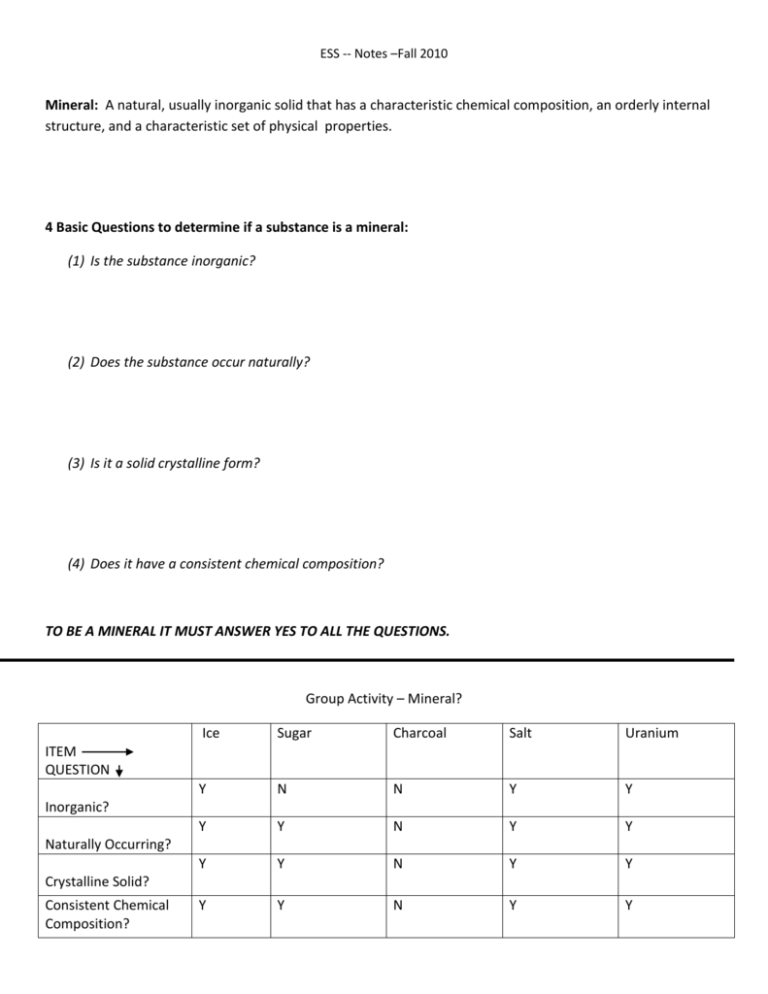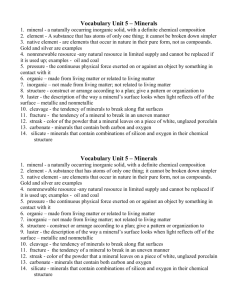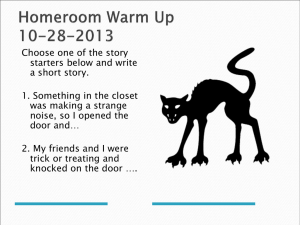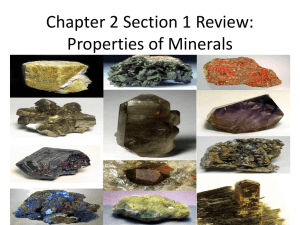ESS -- Notes –Fall 2010 Mineral: A natural, usually inorganic solid
advertisement

ESS -- Notes –Fall 2010 Mineral: A natural, usually inorganic solid that has a characteristic chemical composition, an orderly internal structure, and a characteristic set of physical properties. 4 Basic Questions to determine if a substance is a mineral: (1) Is the substance inorganic? (2) Does the substance occur naturally? (3) Is it a solid crystalline form? (4) Does it have a consistent chemical composition? TO BE A MINERAL IT MUST ANSWER YES TO ALL THE QUESTIONS. Group Activity – Mineral? Ice Sugar Charcoal Salt Uranium Y N N Y Y Y Y N Y Y Y Y N Y Y Y Y N Y Y ITEM QUESTION Inorganic? Naturally Occurring? Crystalline Solid? Consistent Chemical Composition? Kinds of Minerals: (1) Silicate –a mineral that contains a combination of silicon and oxygen and that may also contain one or more metals. Silicon – Si Oxygen – O Makes up 95% of the Earth’s Crust INDICATED BY SiO (2) Non- silicate= a mineral that does not contain compounds of silicon and oxygen. Carbonates -- Chalk Native elements – Silver, Copper Oxides – Anything bonded with oxygen, Rust Sulfates – anything bonded with SO4 Sulfides – Fool’s gold Halides—Salts Ex. NaBr Definitions: Crystal: a solid whose atoms, or ions, or molecules are arranged in a regular, repeating pattern Example: SALT Silicon Oxygen Tetrahedron: the basic unit of the structure of silicate minerals; a silicon ion chemically bonded to and surrounded by four oxygen ions Example: Mineralogists: Examines, analyzes, and classifies minerals. Property How it is identified Inspect the minerals freshly exposed surface Color Unreliable !!!! Streak The color of mineral in powder form. Luster Light that is reflected from a minerals surface Cleavage and Fracture hardness Rub the mineral against a tile called streak plate. Ex. Chalk on chalkboard Metallic – Polished Surface Diamonds- Brilliant Luster No-Luster – Dull/ Earthy Ex. Waxy, Dull, Glossy, Glassy, Cleavage – Tendency of a mineral to break along specific planes. Fracture – The manner in which a mineral breaks along uneven, curved, or irregular surfaces. Ability of a mineral to resist scratching Mohs Hardness Scale Mineral Talc Gypsum Calcite Fluorite Apatite Hardness Common Test Mineral Hardness 1 Easily Scratched by fingernail Feldspar 6 Quartz 7 Easily Scratches glass and Steel Topaz 8 Scratches Quartz 4 Corundum 9 Scratches Topaz 5 Diamond 10 Scratches Everything. 2 3 Barely Scratch by copper penny Common Test ESS -- Notes –Fall 2010 Fluorescence and Phosphorescence Fluorescence – The ability of a mineral to glow under UV (Ultraviolet) light. Ex: Cosmic Bowling Phosphorescence—The ability of a mineral to still glow after being exposed to UV light. Ex. Glow In the Dark Stars. Chatoyancy – Some minerals display a silky material. Result of closely packed fibers in the mineral. Chatoyancy and Asterism Double Refraction Magnetism Radioactivity Asterism – *** The star shaped reflection off of a crystal. Ex. Diamonds Double Refraction is when something is reflected twice The ability of a mineral to attract iron based materials. Ex. Magnet The releasing of energy through the decaying of nuclei. Ex. Geiger Counter Density = MASS/ VOLUME = Ex. A marble has the same amount of mass as a marshmallow but they have different volumes. The marble is much smaller so it is more dense. The marshmallow is larger so it is less dense.









